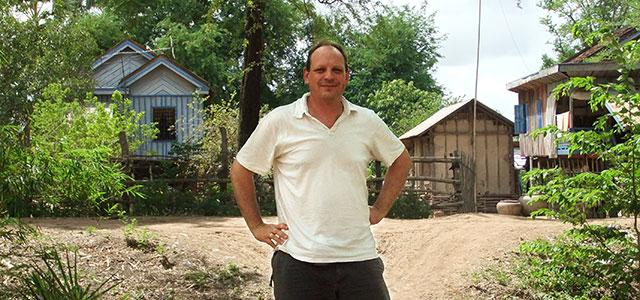
Zachary Zimmer, PhD, in Cambodia.
Graying Globe: Zachary Zimmer Examines Aging Around the World
In their upcoming book, Global Ageing in the Twenty-First Century, Zachary Zimmer, a professor in the Department of Social and Behavioral Sciences at UCSF School of Nursing, and co-editor Susan McDaniel call the aging of the world’s population “among the most important phenomena driving policy around the world over the next number of decades.”
Zimmer has spent nearly two decades looking at the demographics of aging. He has come to understand that where and how people age deeply affects their health – and, possibly, the health of their descendants.
The Route to Health and Aging
The graying of the global population wasn’t always on Zimmer’s radar screen. He graduated from the University of Winnipeg in 1983 with a degree in criminology, but his travels, subsequent interest in international development, and graduate education eventually led him to a job at the Centre on Aging at the University of Victoria, in British Columbia. This led to a PhD program at the University of Michigan that combined his interest in international development with a newfound interest in the demographics of aging.
When the Population Council – a New York-based nonprofit that conducts and disseminates research about critical health and development issues – hired him to start a demographic program on aging, he had the opportunity to travel for the first time to Cambodia. There, he and colleagues from the University of Michigan and the Royal University of Phnom Penh, with funding from the United Nations Population Fund (UNFPA), did the first nationally representative survey of older people in Cambodia. The study quantified the ongoing population effects of government-perpetrated genocide and other upheavals that took place in Cambodia during the 1970s.
That work led to Zimmer’s becoming an advisor to UNFPA in Cambodia, where he partnered with them and the Cambodian government to look at internal migration patterns for the Cambodian Rural Urban Migration Project. The report, which was published in August 2012, found that rural villages lose an average of 4 percent of their population yearly, while cities are experiencing unprecedented population growth. Cambodia’s capital, Phnom Penh, has seen its population almost double over an eight-year period. The report also made a number of recommendations for policy development, such as implementing programs to support older Cambodians living alone in rural areas, to help the government mitigate negative impacts and capitalize on potential positive impacts of the significant demographic changes taking place in the country.
Urban and Rural Aging
Looking at patterns of internal migration and urbanization is important, says Zimmer, because they can have an effect on the health and well-being of individuals, as well as on the government policies needed to meet the health care needs of those individuals. Much of Zimmer’s recent work has focused on these phenomena.
He was the principal investigator on a project called Urban/Rural Disparities in Health and Mortality in China, which found that the mortality rate is about 30 percent higher among rural Chinese than among urban Chinese, across all age groups. In addition, rural areas in China tend to have higher concentrations of elderly residents, because younger people have increasingly migrated to urban areas, where health care is more accessible.
“We found that people in rural areas had to pay for health care, and people in urban areas generally did not,” says Zimmer. “It was a function of the way China has evolved from its Communist system. People in rural areas traditionally got medical care through communal services. When the system changed, those services went away.” In contrast, in urban areas, most people work for state-run businesses or the government, which provides their health care, and they have greater access to modern facilities and advanced medical care.
In a 2010 study, Zimmer and his co-investigators assessed differences in the functional health status of older Chinese and found substantial advantages for those living in urban areas; they were less likely to have functional limitations and less likely to die during the study period.
Giving Back
Health inequities like these intrigue Zimmer. Research suggests that inequities often persist across generations, and Zimmer is currently the co-investigator on a National Institute on Aging (NIA)-funded study (Early Life Conditions, Survival and Health: A Pedigree-Based Population Study) that looks at long-term causes of health and illness, correlating factors such as a father’s level of education with a child’s health as he or she ages.
“We can find these links that go back generationally,” he says. “If there are inequities, not just in your early years, but if there are inequities in your parents’ generation, you carry them forward.”
This comment provides insight into the job of the demographer, who must look at trends and make predictions so society and government can be better prepared to meet a population’s needs. An important part of Zimmer’s work involves training students to use the tools they need to do those tasks. In addition to teaching and mentoring students at the UCSF School of Nursing, he’s conducted training in data analysis for governments in Cambodia and Myanmar, and has taught statistics in Thailand and the Philippines. He says, “My way of giving back is by working directly with people in those parts of the world to help them build their own generation of scholars and academics.”



